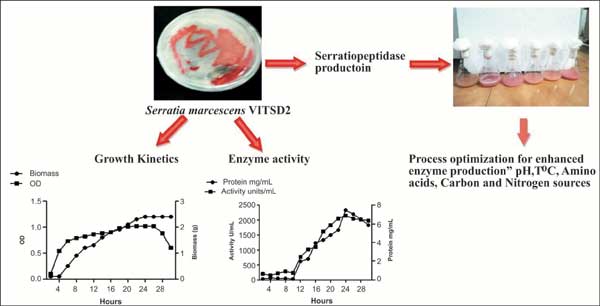Abstract
Serratia is one of the most important groups of bacteria which produces proteolytic enzymes effectively and known to possess anti- inflammatory properties. The main focus of the current study was to optimize the culture conditions of Serratia marcescens VITSD2 for the mass production of serratiopeptidase. Effect of various nutritional and environmental factors were analysed and optimized. Among the different carbon and nitrogen sources tested, mannose and soya bean meal was found to be the best with enzyme activity of 1391 units /mL and 1800 U/mL respectively. The enzyme showed an optimum activity of 1668 U/mL at pH-8 and 1500 U/mL at 25ºC. Maximum peptidase production during fermentation was obtained after 24 h incubation with 1% inoculum in the medium at 25ºC and yielded 1668 U/mL. Lysine stimulated the production of peptidase and the yield obtained was 2410U/mL. Growth curve analysis was done. Maximum serratiopeptidase production was detected after 24 h incubation with 2155 units/mL and cell density of 2.4g/100mL. Hence the observation of the present study clearly indicates that the yield of Serratiopeptidase was found to be maximum by varying the cultural conditions.
Keywords: Anti-inflammatory agents, inflammation, optimisation, peptidases, Serratia marcescens VITSD2, serratiopeptidase.





























